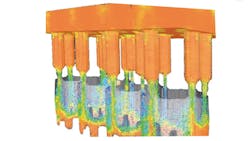Defining, Quantifying, Evaluating Sand-Flow Simulation
Yet, in fact, the foundations of these software programs are quite dissimilar. Let’s consider an everyday example for clarification sake. Many readers recognize the voice of Siri – the Apple Inc. voice recognition software within iPhone and iPad devices. Can Siri recognize us? What about accents … can “she” accommodate even the most subtle variations? The quick answer is, yes. However, Siri was engineered this way.
Competitive offerings are, in many cases, quite different. Most speech recognition devices, for example, focus only on voice inflections. Siri, on the other hand, goes beyond this and “learns” her owner, no matter what peculiarities he or she may exhibit in actual speech. Why was this done? It’s simple: because in the real world humans speak in uniquely different ways. Even within the same language, variations exist. Thus, all speech recognition software is not created equal; rather, some programs are based more in reality than others.
Establishing the latter point of reference is critical to respond to the initial question. As previously explained, software of any sort is confusing to understand, especially when doing comparisons. Even within the same software family variations will exist. This remains invariably true in regard to sand-flow simulation modeling: some software represents reality better than others do.
Now for the science: Most engineers using fluid dynamic computer software (e.g. Magma, Flow3D, etc.) are familiar with the more traditional continuum flows. These work wonderfully when applied to liquid/fluid simulations. Yet, when assessing non-fluid materials, such as sand, they fall short. For instance, the governing equations within popular fluid dynamic software are solved in a eulerian frame of reference, which means that the solution is solved for a finite spatial discretization.
In other words, the fluids are assumed to be continuous and, thus, will flow from any force and fill empty space, regardless of sand grain size (fluids are assumed to be infinitely divisible.)
On the other hand, Arena-Flow is a multi-phase computer program that uses two separate phases for the gas-particle flow. For reference, the first phase is called the “fluid-phase” and characterizes fluid properties — any shear stress induces motion. The second phase focuses on a separate particle, or “granular-phase.” In this instance the particles can support a finite shear stress without motion.
Arena Flow is, in fact, the only foundry software originally designed to account for discrete particle flows, including both the solver and grid generator. The numerical equations are solved on both a eulerian (fixed) grid (i.e., fluid phase) and grid-less, Lagrangian formulation (i.e. discrete particles.)
To review, the main differences can be summed up in three points:
1. Arena-Flow treats particles as discrete entities. Traditional continuum flow software does not. Rather, it assumes any particle at rest, or moving, is a fluid.
2. The user can specify precise information on particle size and density distribution. This allows for accurate density prediction and core sand compaction.
3. Arena-Flow, using the Lagrangian method, properly accounts for particle-wall collisions, as well as particle loading that allows it to model any type of CAD. In other words, you don’t have to tune the model for each specific core.
Join the Conversation. Email Your Questions for ASK Chemicals
Share your insights, opinions, and elaborate on the questions and the experts' answer(s). You must be logged in to the website in order to post your comments.
